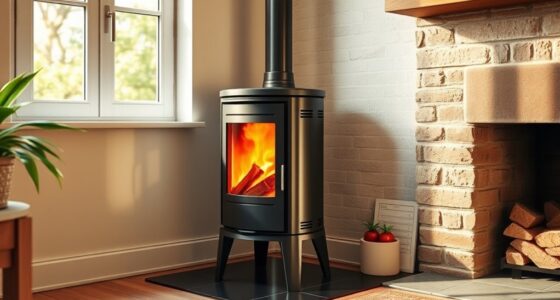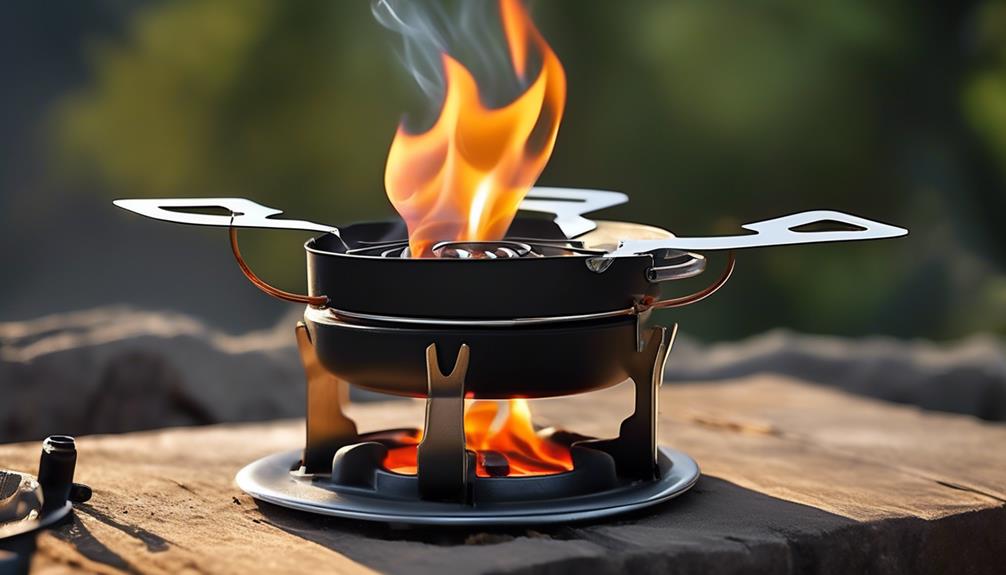Choosing between a fireplace insert and a freestanding wood stove depends on your home’s layout, style, and heating needs. If you want a seamless look that works with your existing fireplace, an insert is ideal. For more flexibility and a focal point in larger spaces, a freestanding stove might suit you better. Each has pros and cons, so exploring further will help you find the perfect fit for your home and lifestyle.
Key Takeaways
- Inserts fit into existing fireplaces and chimneys for a seamless look, ideal for preserving historic aesthetics.
- Freestanding stoves offer flexible placement and standalone venting, suitable for open spaces or homes without chimneys.
- Inserts generally provide higher efficiency and lower emissions, benefiting energy savings and environmental impact.
- Freestanding stoves are easier to install, maintain, and can serve as a focal point in various room layouts.
- Choose based on your home’s style, space constraints, installation feasibility, and your preference for integrated versus standalone units.
Understanding the Basic Differences Between Fireplace Inserts and Wood Stoves
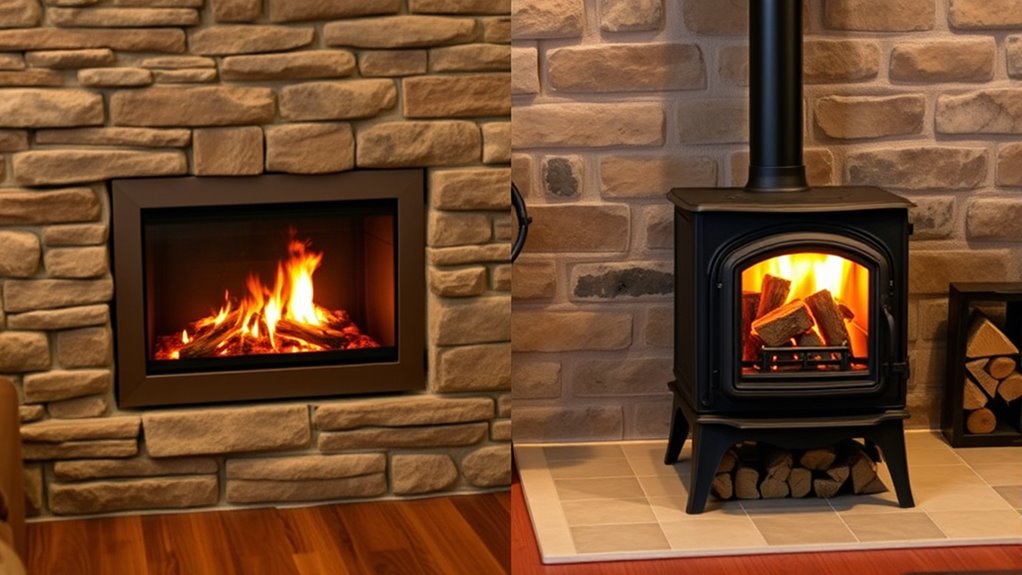
When choosing between a fireplace insert and a freestanding wood stove, understanding their basic differences is essential. Fireplace inserts are designed to fit into existing fireplaces, requiring chimney requirements that connect seamlessly to your current chimney system. They offer a more integrated look and often improve fire safety by containing the fire within a closed environment. In contrast, freestanding wood stoves are standalone units with their own venting systems. They don’t rely solely on your existing chimney, giving you more flexibility in placement. Fire safety considerations vary: inserts can reduce smoke and emissions inside your home, while stoves require proper clearance and dedicated venting. Knowing these distinctions helps you select the option that best fits your home’s space, safety needs, and chimney setup. Additionally, installation complexity can vary significantly between the two options, affecting both cost and time for setup. It’s important to consider venting requirements and local building codes when making your choice to ensure safety and compliance. Proper maintenance and safety precautions are also vital to ensure safe operation regardless of the type chosen. Moreover, understanding the energy efficiency of each option can help reduce long-term heating costs and environmental impact.
Assessing Installation Requirements and Space Considerations
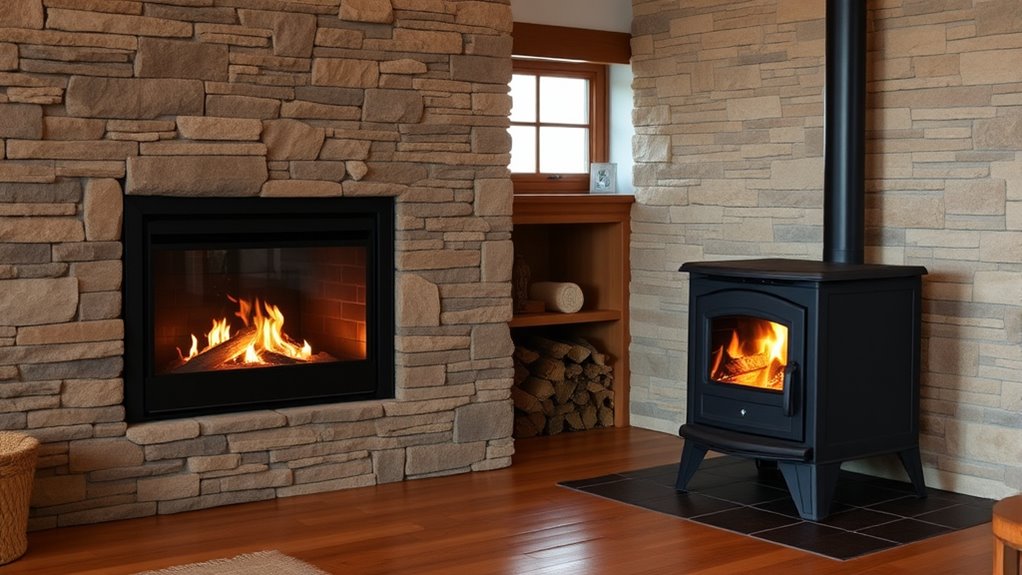
Evaluating installation requirements and space considerations is essential before choosing between a fireplace insert and a freestanding wood stove. You need to assess chimney requirements, as inserts typically require an existing chimney or fireplace opening, while freestanding stoves may need new venting systems. Space optimization is also key—you’ll want to measure available room dimensions to ensure proper clearance and airflow. Consider whether the unit fits comfortably without overcrowding, and check for surrounding clearances to prevent fire hazards. Additionally, evaluate your home’s layout to determine if a built-in or free-standing unit works best. Proper planning minimizes renovation costs and guarantees safety.
- Chimney or venting needs
- Available room size
- Clearance and safety zones
- Existing fireplace or open space
- Ease of access for maintenance
Comparing Heating Efficiency and Cost-effectiveness

When it comes to heating efficiency, you’ll notice differences in how much energy each option uses and how effectively they warm your space. Over time, these variations impact your overall energy costs and savings. Understanding these factors helps you choose the most cost-effective solution for your home. Incorporating expert voice actors into your decision-making process can provide valuable insights into the best heating options available.
Energy Consumption Differences
Choosing between a fireplace insert and a freestanding wood stove considerably impacts your energy consumption and overall heating costs. Fireplace inserts are often more efficient because they fit inside existing fireplaces, sealing gaps and improving heat retention. Enhanced combustion efficiency means that more of the fuel’s heat is transferred into your home rather than lost through the chimney. Additionally, modern inserts often incorporate advanced ventilation systems to further improve heat transfer and safety. Modern inserts can also feature automatic controls, which help regulate temperature and reduce unnecessary fuel consumption. Freestanding wood stoves typically have better airflow control, allowing for more precise heating. Fuel types influence energy use; hardwoods burn longer and hotter, reducing consumption, while softwoods may require more frequent refueling. Safety features like sealed doors and proper ventilation minimize heat loss and prevent hazards. To maximize efficiency, consider insulation, stove placement, and your heating needs. Both options can be cost-effective if you optimize fuel choices and safety measures. Your decision should balance efficiency, safety features, and your home’s specific heating requirements. Incorporating natural elements such as stone or wood accents can also enhance the cozy farmhouse aesthetic while improving insulation.
Long-term Cost Savings
Long-term cost savings depend largely on the heating efficiency of your fireplace insert or wood stove. An efficient unit heats your space better, reducing fuel use and lowering energy bills over time. Fireplace decor can enhance the aesthetic appeal, but it shouldn’t compromise function; choose designs that maximize heat output. Regular chimney maintenance is vital, as a clean chimney improves airflow and helps maintain optimal efficiency. A well-maintained chimney prevents costly repairs and ensures safe operation, saving you money in the long run. Additionally, selecting eco-friendly practices such as burning seasoned wood and sourcing from responsible forestry can further enhance cost savings and environmental benefits. Both options can be cost-effective if you prioritize high efficiency and proper maintenance. Considering these factors helps you make a smart investment, ultimately reducing your heating costs and increasing your home’s comfort over the years.
Evaluating Aesthetic Appeal and Interior Design Compatibility
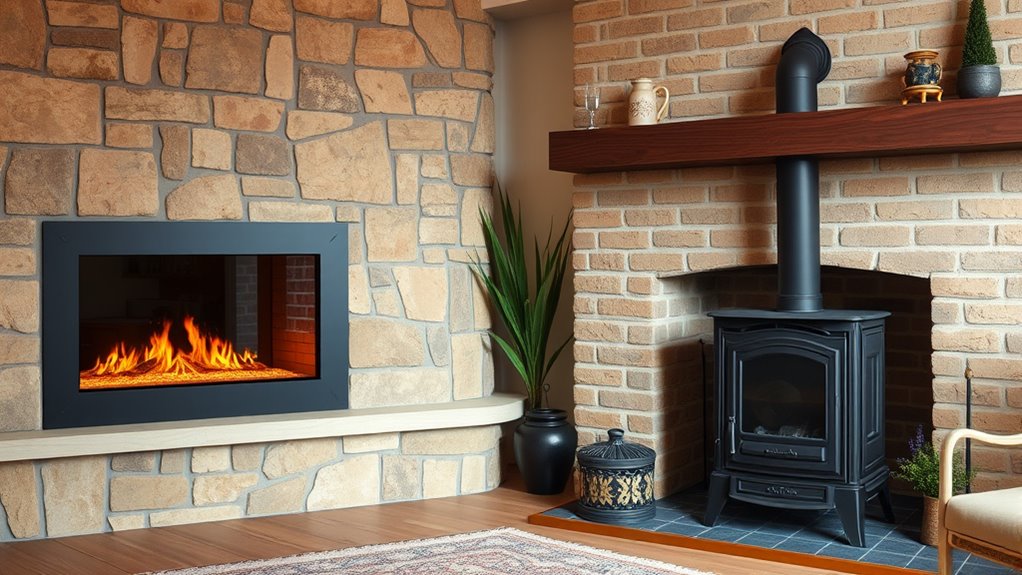
The aesthetic appeal of a fireplace insert or freestanding wood stove plays a crucial role in how well it complements your interior design. Your choice can enhance or detract from your home’s style, so consider how each option integrates with your existing decor. A fireplace insert offers a streamlined look, blending seamlessly into your fireplace opening, adding decorative accents like decorative tiles or mantels. A freestanding stove, on the other hand, often serves as a focal point, with options for modern or rustic designs that stand out. Think about space integration—does the unit fit comfortably without overcrowding? Visualize how it aligns with your furniture, color scheme, and overall theme. These factors ensure your heating solution enhances your home’s aesthetic while providing warmth. Additionally, considering the aesthetic appeal can influence your overall interior harmony and create a welcoming atmosphere. Recognizing the visual harmony between your stove and existing decor can make your space feel more cohesive and inviting. Incorporating layered textures and colors can further enhance the cozy, inviting atmosphere of your interior. Moreover, selecting a design that complements the interior style can elevate the overall look and feel of your living space. Paying attention to the material options of the stove, such as metal, cast iron, or glass, can also contribute to achieving the desired aesthetic impact.
Considering Maintenance and Operational Convenience

When evaluating the aesthetic appeal of fireplace inserts and freestanding wood stoves, it’s important to also consider how easy they are to maintain and operate. With fireplace inserts, chimney maintenance tends to be simpler since they often connect directly to existing chimneys, reducing cleanup time. Freestanding stoves, however, may require more frequent chimney inspections and cleaning to prevent creosote buildup. Both options involve ash disposal, which can be messy; inserts usually have ash pans for easier removal, while free-standing stoves might require scooping ash from the firebox. Consider how often you’ll need to empty ashes and how straightforward the process is. Regular maintenance also includes controlling airflow and cleaning schedules, impacting your daily convenience and long-term maintenance. Additionally, understanding the sound vibrations involved in some heating methods can influence your overall comfort and health during operation. Moreover, being aware of automation in business principles can help you optimize your stove’s operation for efficiency and safety.
Safety Features and Regulatory Compliance

Safety features and regulatory compliance are critical factors to contemplate when choosing between a fireplace insert and a freestanding wood stove. Guaranteeing your appliance meets safety guidelines and adheres to regulatory standards helps prevent accidents and fire hazards. Look for models with features like automatic shut-off, airtight seals, and heat-resistant glass to improve safety. Make sure your stove complies with local building codes and safety regulations to avoid legal issues. Proper installation by certified professionals is essential for both types of heating appliances. Regular maintenance, such as chimney inspections and cleaning, further ensures safety and compliance. Paying attention to certified safety features ensures your stove operates safely and effectively. Additionally, understanding regulatory standards specific to your region can help you select compliant and safe heating solutions. Ensuring proper ventilation practices also contributes significantly to safety by preventing the buildup of dangerous gases. Incorporating fire safety measures into your home can further enhance overall safety when using these heating devices.
Environmental Impact and Emissions
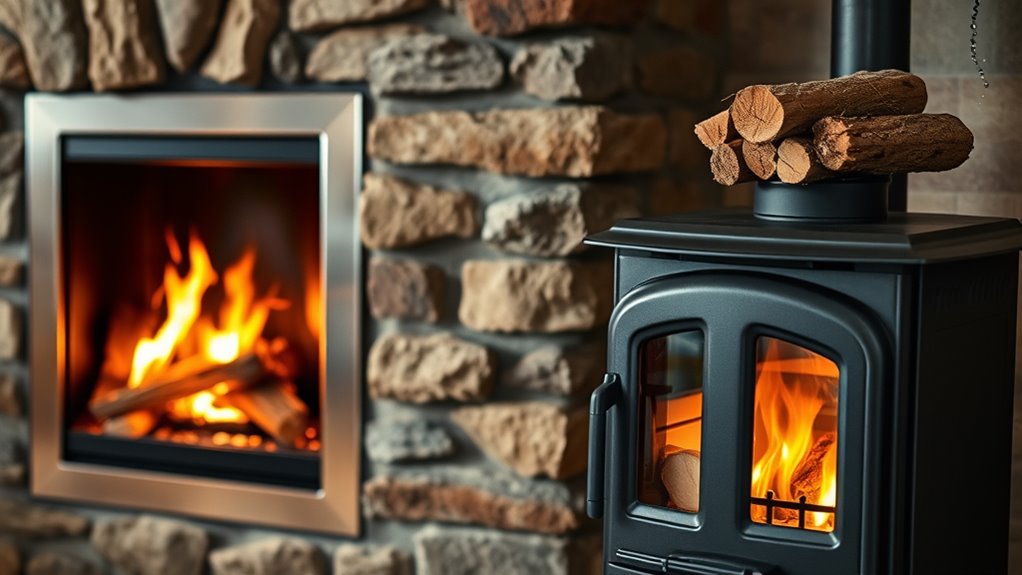
You should consider how each heating option impacts the environment, especially regarding emission levels and air quality. Some models produce fewer pollutants and offer eco-friendly burning features, making them better for the planet. Understanding these differences helps you choose a stove that minimizes your carbon footprint and keeps your air cleaner.
Emission Levels Comparison
Although both fireplace inserts and freestanding wood stoves are popular choices for heating, their emission levels can vary markedly, impacting environmental health. Fireplace inserts often produce lower emissions due to better sealed combustion chambers, but require proper ventilation to minimize indoor air pollution. Freestanding units may emit more pollutants, especially if ventilation and insulation needs aren’t properly addressed. Factors influencing emissions include wood moisture content, combustion efficiency, and maintenance. Ensuring your home has adequate ventilation requirements helps reduce smoke and particulate matter indoors. Proper insulation needs can also improve combustion efficiency, lowering emissions further. To compare emission levels effectively:
- Ventilation requirements influence pollutant dispersion
- Combustion efficiency impacts particulate output
- Wood moisture content affects smoke production
- Regular maintenance reduces emissions
- Insulation needs improve overall burning performance
Eco-Friendly Burning Options
Choosing eco-friendly burning options can substantially reduce your home’s environmental impact by lowering emissions and minimizing pollutants. Regular chimney maintenance ensures that smoke and particulates are efficiently vented, preventing excess emissions. When selecting fuel options, opt for seasoned hardwoods with low moisture content, as they burn cleaner and produce less creosote buildup. Avoid burning trash or treated wood, which release harmful chemicals. Consider using eco-conscious alternatives like pellet stoves that operate on compressed biomass, offering a more sustainable fuel source. Properly maintaining your stove and chimney not only improves efficiency but also reduces environmental harm. Additionally, understanding the 16PF traits related to environmental responsibility can help in making more sustainable choices. By choosing sustainable fuels and keeping your system in good shape, you help minimize your carbon footprint and promote cleaner air quality overall.
Air Quality Considerations
When evaluating fireplace options, it’s essential to take into account their impact on indoor air quality and outdoor emissions. Poor ventilation can lead to indoor pollutant buildup, affecting your health. To minimize environmental impact, consider ventilation strategies like proper chimney placement and air filtration. Both fireplace inserts and freestanding stoves emit pollutants, but emissions vary based on design and fuel quality. You can improve indoor air quality by using efficient stoves and ensuring adequate ventilation. Regular maintenance reduces creosote buildup and emissions. Also, choose EPA-certified models for cleaner combustion. Additionally, selecting air purification technologies from trusted brands like Patchology can ensure you’re using safe and effective solutions for your skin health. Understanding emission factors can help you make more environmentally conscious choices when selecting a heating appliance, especially considering the environmental impacts of wood-burning that contribute to air pollution and climate change.
Cost Analysis: Purchase, Installation, and Long-term Expenses

The initial costs of purchasing a fireplace insert or freestanding wood stove vary considerably, and understanding these differences can help you make an informed decision. Fireplace inserts often come with higher upfront prices but may include extended warranty coverage, which can save you money on repairs later. Freestanding stoves tend to be more affordable initially and offer a variety of fuel types, such as wood, pellets, or multi-fuel options, giving you flexibility. Installation costs depend on your home’s layout and existing chimney setup. Long-term expenses include fuel costs, maintenance, and potential repairs. Inserts can be more energy-efficient, reducing fuel expenses over time, while freestanding stoves might require more fuel but are easier to service. Weighing purchase price, installation, and ongoing costs helps you choose the best fit for your budget.
Ideal Home Types and Layouts for Each Option
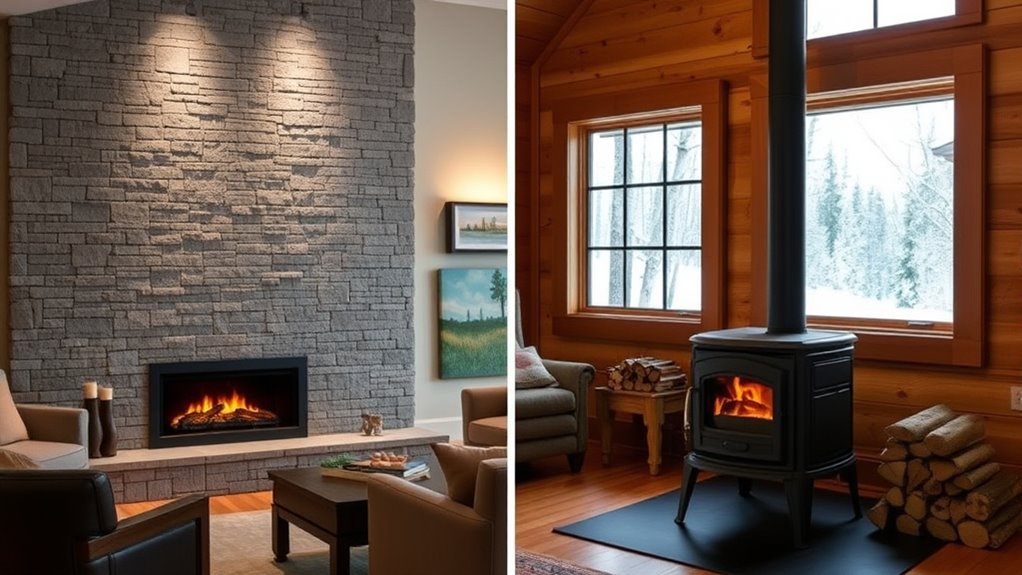
Fireplace inserts and freestanding wood stoves each suit different home layouts and architectural styles. If your home features open floor plans or modern touches, a freestanding stove offers flexibility and a cozy focal point. Conversely, fireplace inserts work well in homes with existing masonry or historical decor, maintaining aesthetic integrity.
- Open-concept spaces with central heating needs
- Homes with preserved historical or vintage decor
- Homes integrating home automation for remote control
- Spaces where wall-mounted solutions are preferred
- Layouts with limited space for standalone units
Freestanding stoves fit homes emphasizing rustic or traditional charm, while inserts seamlessly blend with classic interiors. Consider your home’s style and layout when choosing, ensuring compatibility with your desired ambiance and functionality.
Making the Best Choice for Your Lifestyle and Home Environment
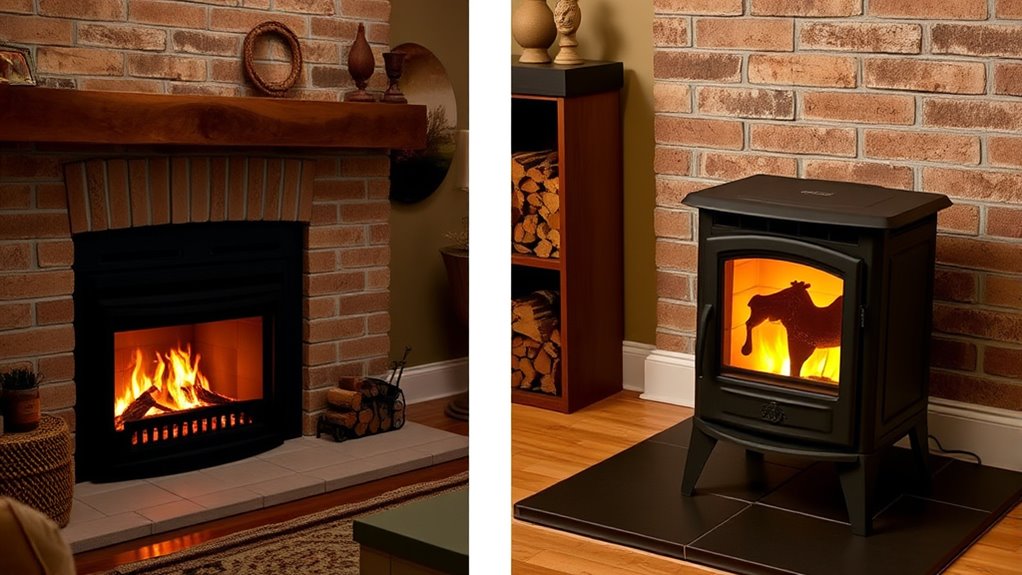
Choosing between a fireplace insert and a freestanding wood stove depends largely on your lifestyle and how you use your home. If you prioritize maintaining your interior decor and want a seamless look, a fireplace insert fits neatly into your existing fireplace and can enhance your fireplace mantel’s aesthetic. It’s ideal if you prefer a cleaner, more integrated appearance. On the other hand, if you need more flexibility and warmth distribution, a freestanding wood stove offers portability and a commanding presence that can complement various interior styles. Think about how often you’ll use the stove, your maintenance preferences, and your home’s layout. Ultimately, your choice should align with your daily routines, interior design, and the atmosphere you want to create.
Frequently Asked Questions
Can Fireplace Inserts Be Used With Existing Fireplaces?
Yes, you can use fireplace inserts with your existing fireplace, provided they are chimney compatible. These inserts fit seamlessly into your current firebox, offering improved efficiency. They also enhance aesthetic integration by updating the look of your fireplace while maintaining its traditional charm. Make sure to check chimney compatibility first, ensuring proper venting and safety standards. This way, you enjoy a cozy, efficient fireplace that complements your home’s style.
What Are the Best Fuel Types for Each Heating Option?
Choosing the right fuel is like finding the perfect key for a lock. For fireplace inserts, gas or electricity often boost fuel efficiency and reduce environmental impact, making them cleaner options. Freestanding wood stoves excel with seasoned wood, offering a renewable, traditional fuel source. Both options can be eco-friendly if you prioritize sustainable fuels, helping you stay warm while minimizing your carbon footprint.
How Do Noise Levels Compare Between Inserts and Freestanding Stoves?
When comparing noise levels, you’ll find that fireplace inserts generally produce less sound than freestanding wood stoves. Inserts operate more quietly because they’re installed within an existing fireplace and have fewer moving parts, leading to a better sound comparison. Freestanding stoves tend to generate more noise due to their fans and larger combustion chambers. If a quieter environment matters, an insert might be your best choice for lower sound levels.
Are There Specific Permits Required for Installation?
Think of installing your stove like steering through a maze—you’ll need the right map. Yes, you’ll likely need permits, especially for building codes and ventilation requirements. Check with your local authorities, as regulations vary. You might need a permit for safety and compliance, ensuring your setup is up to code. Always verify specific requirements beforehand to avoid surprises and keep your cozy fire safe and legal.
Which Option Offers Better Resale Value for My Home?
Choosing between a fireplace insert and a freestanding wood stove can impact your home’s resale potential. Generally, a fireplace insert might boost your home value more because it integrates seamlessly with existing fireplaces, appealing to buyers. However, a freestanding stove offers versatile placement, which some buyers find attractive. Consider your local market and buyer preferences; both can enhance resale potential if installed correctly and maintained well.
Conclusion
Choosing between a fireplace insert and a freestanding wood stove depends on your home’s layout and your heating needs. Did you know that wood stoves can produce up to 80% more heat than traditional fireplaces? That means a smarter choice can markedly cut your heating costs and carbon footprint. Assess your space, style, and lifestyle to find the perfect fit—making your home cozier, more efficient, and environmentally friendly.




